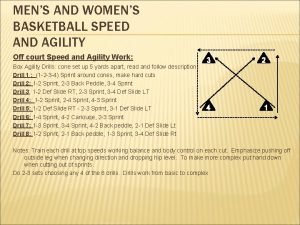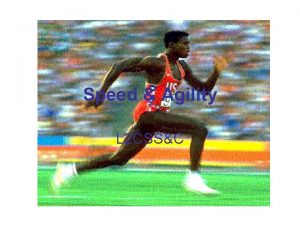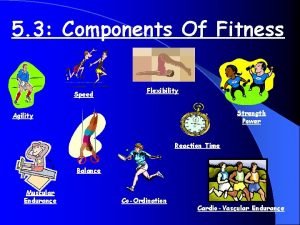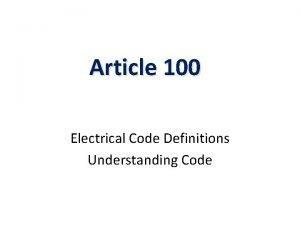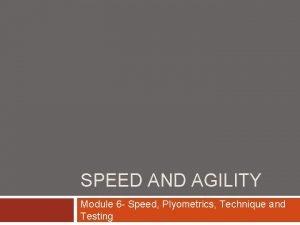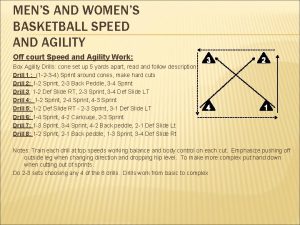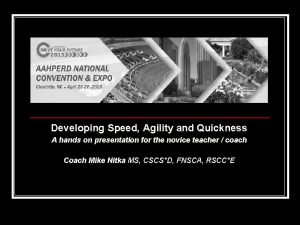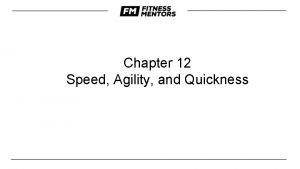SPEED AND AGILITY What does speed consist of



















- Slides: 19

SPEED AND AGILITY

What does speed consist of? • SPEED, IN ATHLETIC TERMS, IS A COMBINATION OF: • ACCELERATION • CHANGE OF DIRECTION • LATERAL MOVEMENT • LINEAR MOVEMENT Click here to see the top 10 fastest football players in 2015! https: //www. youtube. com/watch? v=ige. N VJq. FYKk

SPEED • Speed: Refers to "how fast an object is moving. " Speed can be thought of as the rate at which an object covers distance. • Acceleration Speed: Refers to the rate at which an object is changing its velocity. An object is accelerating if it is increasing its velocity. • Change of Direction: Refers to the act of changing the direction in which something is orientated. • Lateral Speed: Refers to speed in a side to side path. • Linear Speed: Refers to speed in a straight line path.

Gait analysis • Stride (Gait) Analysis: Refers to the continuous repetitive pattern of running (or walking). • The gait cycle is split into two main phases, stance and swing, with one complete gait cycle including both a stance and swing phase.

Muscles used during gait v https: //www. youtube. com/watch? v=6 Ob. Nn. CTV 6 MY

Agility v The ability to change the direction of the body in an efficient and effective manner v Nimbleness

AGILITY Click here to see Carlin Isles – currently the fastest rugby player in the world! Agility depends on the following skills: • Balance Anticipation Changing Velocities Kinesthetic Awareness Reaction Time https: //www. youtube. com/watch? v=tx. Oqu. Lrvi. W g -over 20 metres, Isles is 0. 22 sec faster than Usain Bolt -Over 40 yards, Isles 4. 22 sec time is faster than any player electronically recorded in the history of the NFL Combine -- Isles’s one-leg vertical jump, of 42 in, puts him 8 th in the top 10 NBA players of all time

Components of Agility • Balance: Refers to the ability to maintain equilibrium when stationary or moving (i. e. not to fall over) through the coordinated actions of our sensory functions (eyes, ears and the proprioceptive organs in our joints) • Anticipation: Refers to the capacity of an athlete to predict what is going to occur in a given situation. This strategy allows the athlete to preplan his future movements. Spatial anticipation can help to reduce reaction times. (i. e. Penalty kicks in soccer)

Components of Agility • Changing Velocities Because velocity is the rate of motion of an object in a specific direction, either an increase or decrease in the object's speed or a change in its direction of travel causes its velocity to change. • Reaction Time Refers to the elapsed time between the initiation of an action and the required response

Components of Agility v Kinesthetic Awareness: Refers to a sensory skill that your body uses to know where it is in space. Many Structures in your body have nerve receptors which send specific information to the brain. Your Brain receives this type of feedback information from your ears, eyes, muscles, ligaments, skin, in order to guide your body through smooth movements, stay balanced, maintain posture, and react to the immediate environment.

MOMENTUM & INERTIA • Momentum: Refers to the product of the velocity and the inertial mass of the object. • Inertia: Refers to how hard it is to change the current state of the system. The higher the inertia of a system, the harder it is to change the velocity, acceleration, direction of the system. Objects having higher masses have higher inertia. • https: //m. youtube. com/watch? v=g. It. FG 82 q. Ex. E

Get Moving Efficiently v Click here to see Usain Bolt in slow motion v https: //www. youtube. com/watch? v=PH-3 c. Hx. XAK 0

GET MOVING EFFICIENTLY Body position: • The body functions best when it’s segments are in a balanced, neutral alignment. • The nerves are unobstructed, the blood flows more efficiently, and the muscles work to their full potential. This position also relieves stress on joints and the skeletal structure. • To move and accelerate efficiently, a good rule of thumb is to work towards your shin angle matching your chest/torso angle. Its also crucial to work towards keeping your feet underneath your body/hips as much as possible to load as efficiently as possible.

Get Moving Efficiently • Visual Focus: The athlete's head should be in a neutral position with eyes focused directly ahead, regardless of the direction or movement pattern being used by the athlete. • Exceptions to this guideline will occur when the athlete is required to focus on another athlete or object. • Additionally, the head and eyes should lead all movements and finding a new focus point should initiate all directional changes and transitions.

Get Moving Efficiently v Deceleration: The ability of an athlete to decelerate from a given velocity is essential for changing directions. v Key to stopping the body when decelerating from a sprint or landing from a jump is the eccentric contraction. When an athlete lands from a jump, to leap into another, the muscles are ‘stretched under load’ (the eccentric contraction); in other words, the muscle fibres lengthen as they absorb the impact. This process also stores energy. The stronger the athlete’s muscles are eccentrically, the greater control they can exert during landing. v Therefore, the strain that is placed on the knee and ankle joints is lower, and more power is available for the subsequent concentric

Get Moving Efficiently • Arm Action: Powerful arm movement during transitional and directional changes is essential in order to reacquire a high rate of speed. • Inadequate or improper arm movement may result in a loss of speed or efficiency. • The arm swing during acceleration is very long, especially in the back swing. This is, again, due to the fact we want longer foot contact so more force can be applied. The arm swing must match the leg action so coordination can exist. • Rule of thumb: try to move your arms from cheek to cheek. ( Butt cheek to face cheek)

Get Moving Efficiently v Leg action: The process of accelerating is based on long powerful leg actions that never become over-strides, but more piston-like leg actions. v The piston-like action always allows a down-and-back shin angle, so pushing is in order and pulling is not.

GETTING FASTER • Acceleration Speed: • https: //www. youtube. com/watch? v=PRpxc. Q 2 Zv. Cs • https: //www. youtube. com/watch? v=NDo. K 3 Xn 7 ih. E • Change of Direction: https: //www. youtube. com/watch? v=79 T 8 QPyg_I 4 • Lateral Speed: https: //www. youtube. com/watch? v=x 0 S 8 Cb. Rm. WTg • Linear Speed: • https: //www. youtube. com/watch? v=9 BIk. QTz. J 9 b. E • https: //www. youtube. com/watch? v=YNLxum. VRvi. U • Arm Action: https: //www. youtube. com/watch? v=Yqn. IYm. Ke 4_I • Leg Action: https: //www. youtube. com/watch? v=_l. Qw. MBRHdzc

Fastest Women Fastest Men https: //www. youtube. com/watc h? v=rsk. YSVf. Wl 48 https: //www. youtube. com/watc h? v=GCWd. Xh. T 7 vxg
 Average hexagon agility test
Average hexagon agility test Speed and agility drills for basketball
Speed and agility drills for basketball Fitness components
Fitness components Speed and agility frequency
Speed and agility frequency Great britain countries
Great britain countries What does the united kingdom consist of
What does the united kingdom consist of What consists of the uk
What consists of the uk White blood chapter 14
White blood chapter 14 Great britain consist of
Great britain consist of What does an ict system consist of
What does an ict system consist of Civil service seeing the big picture example
Civil service seeing the big picture example Static balance
Static balance Worksheet formulas consist of two components: operands and
Worksheet formulas consist of two components: operands and Formula for speed distance and time
Formula for speed distance and time Safety net drop tests must consist of a
Safety net drop tests must consist of a Wet gum method is used for preparation of
Wet gum method is used for preparation of Accessible vs readily accessible
Accessible vs readily accessible Disadvantages of absolute loader
Disadvantages of absolute loader Servletcontext and servletconfig
Servletcontext and servletconfig Ipo programming
Ipo programming

